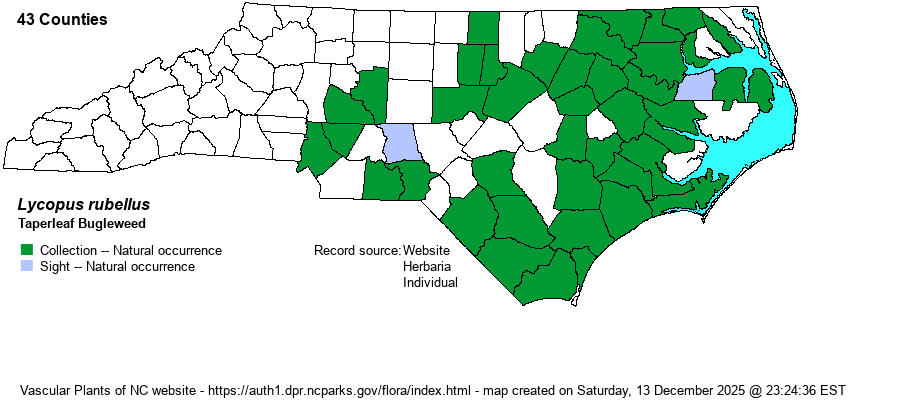| Author | Moench | |
| Distribution | Nearly throughout the Coastal Plain, but absent from the Sandhills, where Lycopus cokeri seems to replace it. Also, ranges into the eastern portions of the Piedmont, rarely as far west as Person, Rowan, and Mecklenburg counties.
This is a wide-ranging Eastern species, except generally avoiding the Appalachian Mountains. Ranges from MA and IA south to southern FL and eastern TX.
| |
| Abundance | Frequent to common in most of the Coastal Plain, but very rare to absent from the Sandhills, perhaps as the waters there are mostly too acidic for it. Seems not to be numerous in the extreme northeastern counties, though this could be an artifact of collecting. Rare in the eastern Piedmont, mainly limited to the northeastern portions. | |
| Habitat | This is a species of fairly rich but wet to damp ground (as opposed to acidic waters of savanans, pocosins, etc.). It grows in swamps, bottomlands, ditches, marshes, and various lake and pond margins. | |
| Phenology | Blooms from June to frost, fruiting shortly after flowering. | |
| Identification | Like about all others in the genus, it has an unbranched, or branched sparingly, stem growing to 1.5-2 feet tall. As with them, it has numerous paired/opposite leaves and many whorls of very small white flowers in the leaf axils. Identify this numerous Coastal Plain species by the leaves that gradually taper to the stem, and thus can look petiolate even if not truly with a petiole. Each leaf blade is elliptical to lanceolate, about 2-2.5 inches long, and about 3/4-inch wide, with scattered teeth. The very widespread and common L. virginicus has leaves that clearly have a long petiole, where the leaf blade does not gradually taper to the stem but is rounded to a distinct petiole. If still not sure, a hand lens may be needed, as in L. rubellus the calyx lobes are acuminate (long and sharply pointed), but in L. virginicus they are obtuse to acute. You should be easily able to find this species in ditches or other mostly sunny and muddy wetlands. | |
| Taxonomic Comments | This species account is for L. rubellus (strict sense). Weakley (2018) and a few other references have split out L. angustifolius from L. rubellus. However, RAB (1968) and many references include that taxon as a variety; in such case, this taxon becomes L. rubellus var. rubellus.
| |
| Other Common Name(s) | Stalked Bugleweed, Stalked Water-horehound, Taperleaf Water-horehound | |
| State Rank | S4 | |
| Global Rank | G5 | |
| State Status | | |
| US Status | | |
| USACE-agcp | OBL link |
| USACE-emp | OBL link |

